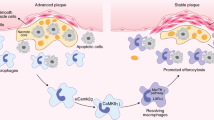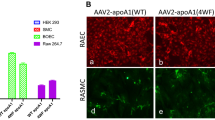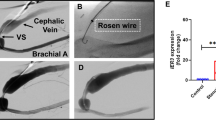Abstract
Both atherosclerosis and arterial interventions induce oxidative stress mediated in part by nicotinamide adenine dinucleotide phosphate (NADPH) oxidases that have a pivotal role in the development of neointimal hyperplasia and restenosis. For small interfering RNA (siRNA) targeting of the NOX2 (Cybb) component of the NADPH oxidase to prevent restenosis, gene transfer with viral vectors is effective, but raises safety issues in humans. We developed a new approach using the amino-acid-based nanoparticle HB-OLD7 for local delivery of siRNA targeting NOX2 to the arterial wall. siRNA–nanoparticle complexes were transferred into the regional carotid artery walls after angioplasty in an atherosclerotic rat model. Compared with angioplasty controls, Cybb gene expression (measured by quantitative reverse transcriptase-PCR) in the experimental arterial wall 2 weeks after siRNA was reduced by >87%. The neointima-to-media-area ratio was decreased by >83%, and the lumen-to-whole-artery area ratio was increased by >89%. Vital organs showed no abnormalities and splenic Cybb gene expression showed no detectable change. Thus, local arterial wall gene transfer with HB-OLD7 nanoparticles provides an effective, nonviral system for efficient and safe local gene transfer in a clinically applicable approach to knock down an NADPH oxidase gene. Local arterial knockdown of the Cybb gene significantly inhibited neointimal hyperplasia and preserved the vessel lumen without systemic toxicity.
This is a preview of subscription content, access via your institution
Access options
Subscribe to this journal
Receive 12 print issues and online access
$259.00 per year
only $21.58 per issue
Buy this article
- Purchase on Springer Link
- Instant access to full article PDF
Prices may be subject to local taxes which are calculated during checkout







Similar content being viewed by others
Accession codes
References
Morice MC, Serruys PW, Sousa JE, Fajadet J, Ban Hayashi E, Perin M et al. A randomized comparison of a sirolimus-eluting stent with a standard stent for coronary revascularization. N Engl J Med 2002; 346: 1773–1780.
Moses JW, Leon MB, Popma JJ, Fitzgerald PJ, Holmes DR, O’Shaughnessy C et al. Sirolimus-eluting stents versus standard stents in patients with stenosis in a native coronary artery. N Engl J Med 2003; 349: 1315–1323.
Grube E, Silber S, Hauptmann KE, Mueller R, Buellesfeld L, Gerckens U et al. TAXUS I: six- and twelve-month results from a randomized, double-blind trial on a slow-release paclitaxel-eluting stent for de novo coronary lesions. Circulation 2003; 107: 38–42.
Austin D, Oldroyd KG, Holmes Jr DR, Rihal CS, Galbraith PD, Ghali WA et al. Drug-eluting stents: a study of international practice. Am Heart J 2009; 158: 576–584.
Windecker S, Juni P . Safety of drug-eluting stents. Nat Clin Pract Cardiovasc Med 2008; 5: 316–328.
Rosamond W, Flegal K, Furie K, Go A, Greenlund K, Haase N et al. Heart disease and stroke statistics—2008 update: a report from the American Heart Association Statistics Committee and Stroke Statistics Subcommittee. Circulation 2008; 117: e25–146.
van der Hoeven BL, Pires NM, Warda HM, Oemrawsingh PV, van Vlijmen BJ, Quax PH et al. Drug-eluting stents: results, promises and problems. Int J Cardiol 2005; 99: 9–17.
Muni NI, Gross TP . Problems with drug-eluting coronary stents—the FDA perspective. N Engl J Med 2004; 351: 1593–1595.
Stettler C, Wandel S, Allemann S, Kastrati A, Morice MC, Schomig A et al. Outcomes associated with drug-eluting and bare-metal stents: a collaborative network meta-analysis. Lancet 2007; 370: 937–948.
Mohazzab KM, Kaminski PM, Wolin MS . NADH oxidoreductase is a major source of superoxide anion in bovine coronary artery endothelium. Am J Physiol 1994; 266: H2568–H2572.
Jones SA, O’Donnell VB, Wood JD, Broughton JP, Hughes EJ, Jones OT . Expression of phagocyte NADPH oxidase components in human endothelial cells. Am J Physiol 1996; 271: H1626–H1634.
Irani K, Xia Y, Zweier JL, Sollott SJ, Der CJ, Fearon ER et al. Mitogenic signaling mediated by oxidants in Ras-transformed fibroblasts. Science 1997; 275: 1649–1652.
Bedard K, Krause KH . The NOX family of ROS-generating NADPH oxidases: physiology and pathophysiology. Physiol Rev 2007; 87: 245–313.
Kalinina N, Agrotis A, Tararak E, Antropova Y, Kanellakis P, Ilyinskaya O et al. Cytochrome b558-dependent NAD(P)H oxidase-phox units in smooth muscle and macrophages of atherosclerotic lesions. Arterioscler Thromb Vasc Biol 2002; 22: 2037–2043.
Martino F, Loffredo L, Carnevale R, Sanguigni V, Martino E, Catasca E et al. Oxidative stress is associated with arterial dysfunction and enhanced intima-media thickness in children with hypercholesterolemia: the potential role of nicotinamide-adenine dinucleotide phosphate oxidase. Pediatrics 2008; 122: e648–e655.
Vendrov AE, Hakim ZS, Madamanchi NR, Rojas M, Madamanchi C, Runge MS . Atherosclerosis is attenuated by limiting superoxide generation in both macrophages and vessel wall cells. Arterioscler Thromb Vasc Biol 2007; 27: 2714–2721.
Li JM, Zhang X, Nelson PR, Odgren PR, Nelson JD, Vasiliu C et al. Temporal evolution of gene expression in rat carotid artery following balloon angioplasty. J Cell Biochem 2007; 101: 399–410.
Kanellakis P, Nestel P, Bobik A . Angioplasty-induced superoxide anions and neointimal hyperplasia in the rabbit carotid artery: suppression by the isoflavone trans-tetrahydrodaidzein. Atherosclerosis 2004; 176: 63–72.
Jacobson GM, Dourron HM, Liu J, Carretero OA, Reddy DJ, Andrzejewski T et al. Novel NAD(P)H oxidase inhibitor suppresses angioplasty-induced superoxide and neointimal hyperplasia of rat carotid artery. Circ Res 2003; 92: 637–643.
Abid MR, Yano K, Guo S, Patel VI, Shrikhande G, Spokes KC et al. Forkhead transcription factors inhibit vascular smooth muscle cell proliferation and neointimal hyperplasia. J Biol Chem 2005; 280: 29864–29873.
Banno H, Takei Y, Muramatsu T, Komori K, Kadomatsu K . Controlled release of small interfering RNA targeting midkine attenuates intimal hyperplasia in vein grafts. J Vasc Surg 2006; 44: 633–641.
Matsumae H, Yoshida Y, Ono K, Togi K, Inoue K, Furukawa Y et al. CCN1 knockdown suppresses neointimal hyperplasia in a rat artery balloon injury model. Arterioscler Thromb Vasc Biol 2008; 28: 1077–1083.
Jin S, Ye K . Nanoparticle-mediated drug delivery and gene therapy. Biotechnol Prog 2007; 23: 32–41.
Libby P, Ridker PM, Maseri A . Inflammation and atherosclerosis. Circulation 2002; 105: 1135–1143.
Li JM, Singh MJ, Itani M, Vasiliu C, Hendricks G, Baker SP et al. Recombinant human thrombomodulin inhibits arterial neointimal hyperplasia after balloon injury. J Vasc Surg 2004; 39: 1074–1083.
Li JM, Eslami MH, Rohrer MJ, Dargon P, Joris I, Hendricks G et al. Interleukin 18 binding protein (IL18-BP) inhibits neointimal hyperplasia after balloon injury in an atherosclerotic rabbit model. J Vasc Surg 2008; 47: 1048–1057.
Mueller CF, Laude K, McNally JS, Harrison DG . ATVB in focus: redox mechanisms in blood vessels. Arterioscler Thromb Vasc Biol 2005; 25: 274–278.
Wong G, Li JM, Hendricks G, Eslami MH, Rohrer MJ, Cutler BS . Inhibition of experimental neointimal hyperplasia by recombinant human thrombomodulin coated ePTFE stent grafts. J Vasc Surg 2008; 47: 608–615.
Kleinman ME, Yamada K, Takeda A, Chandrasekaran V, Nozaki M, Baffi JZ et al. Sequence- and target-independent angiogenesis suppression by siRNA via TLR3. Nature 2008; 452: 591–597.
Cho WG, Albuquerque RJ, Kleinman ME, Tarallo V, Greco A, Nozaki M et al. Small interfering RNA-induced TLR3 activation inhibits blood and lymphatic vessel growth. Proc Natl Acad Sci USA 2009; 106: 7137–7142.
Babior BM . NADPH oxidase. Curr Opin Immunol 2004; 16: 42–47.
Malech HL, Hickstein DD . Genetics, biology and clinical management of myeloid cell primary immune deficiencies: chronic granulomatous disease and leukocyte adhesion deficiency. Curr Opin Hematol 2007; 14: 29–36.
Robbins M, Judge A, Ambegia E, Choi C, Yaworski E, Palmer L et al. Misinterpreting the therapeutic effects of siRNA caused by immune stimulation. Hum Gene Ther 2008; 19: 991–999.
Daemen J, Boersma E, Flather M, Booth J, Stables R, Rodriguez A et al. Long-term safety and efficacy of percutaneous coronary intervention with stenting and coronary artery bypass surgery for multivessel coronary artery disease: a meta-analysis with 5-year patient-level data from the ARTS, ERACI-II, MASS-II, and SoS trials. Circulation 2008; 118: 1146–1154.
Investigators ICSS. Carotid artery stenting compared with endarterectomy in patients with symptomatic carotid artery stenosis (International Carotid Stenting Study):an intrim analysis of a randomised controlled trial. Lancet 2010; 375: 985–997.
Csanyi G, Taylor WR, Pagano PJ . NOX and inflammation in the vascular adventitia. Free Radic Biol Med 2009; 47: 1254–1266.
Rana TM . Illuminating the silence: understanding the structure and function of small RNAs. Nat Rev Mol Cell Biol 2007; 8: 23–36.
Baigude H, McCarroll J, Yang CS, Swain PM, Rana TM . Design and creation of new nanomaterials for therapeutic RNAi. ACS Chem Biol 2007; 2: 237–241.
Yang PY, Rui YC, Lu L, Li TJ, Liu SQ, Yan HX et al. Time courses of vascular endothelial growth factor and intercellular adhesion molecule-1 expressions in aortas of atherosclerotic rats. Life Sci 2005; 77: 2529–2539.
Elashoff JD . nQuery Advisor Release 6.0 User's Guide. Statistical Solution Inc.: Los Angeles, CA, 2005.
McLean RA, Sanders WL, Stroup WW . A unified approach to mixed linear models. Am Stat 1991; 45: 54–64.
Acknowledgements
We thank Tariq M Rana, PhD and Huricha Baigude, PhD, Burnham Institute for Medical Research, La Jolla, CA, for providing nanoparticles and for helpful study discussions; Stephen Baker, MScPH, Senior Biostatistician, Department of Cell Biology and Information Resources for assistance of statistical analysis; Paul S Furcinitti, PhD, Director of Digital Light Microscopy Core Facility for confocal microscopy and image analysis, and Jeffrey Nickerson, PhD, Department of Cell Biology, Director of Confocal Microscopy Core Facility, the University of Massachusetts Medical School. This study was supported by the Bugher Foundation (to JML), NIH grant numbers R21AI079788 and R01DK54369 (to PEN), R21EB007767 (to MJG), R01HL075353 (to LMM) and University of Massachusetts Medical School Chair Research Fund (to LMM).
Author information
Authors and Affiliations
Corresponding author
Ethics declarations
Competing interests
The authors declare no conflict of interest.
Additional information
Supplementary Information accompanies the paper on Gene Therapy website
Rights and permissions
About this article
Cite this article
Li, J., Newburger, P., Gounis, M. et al. Local arterial nanoparticle delivery of siRNA for NOX2 knockdown to prevent restenosis in an atherosclerotic rat model. Gene Ther 17, 1279–1287 (2010). https://doi.org/10.1038/gt.2010.69
Received:
Revised:
Accepted:
Published:
Issue Date:
DOI: https://doi.org/10.1038/gt.2010.69
Keywords
This article is cited by
-
Advances in treatment strategies based on scavenging reactive oxygen species of nanoparticles for atherosclerosis
Journal of Nanobiotechnology (2023)
-
Nanomedicines for cardiovascular disease
Nature Cardiovascular Research (2023)
-
Nanomaterials alleviating redox stress in neurological diseases: mechanisms and applications
Journal of Nanobiotechnology (2022)
-
Nanoparticles in the diagnosis and treatment of vascular aging and related diseases
Signal Transduction and Targeted Therapy (2022)
-
Discovery of novel peptides targeting pro-atherogenic endothelium in disturbed flow regions -Targeted siRNA delivery to pro-atherogenic endothelium in vivo
Scientific Reports (2016)



